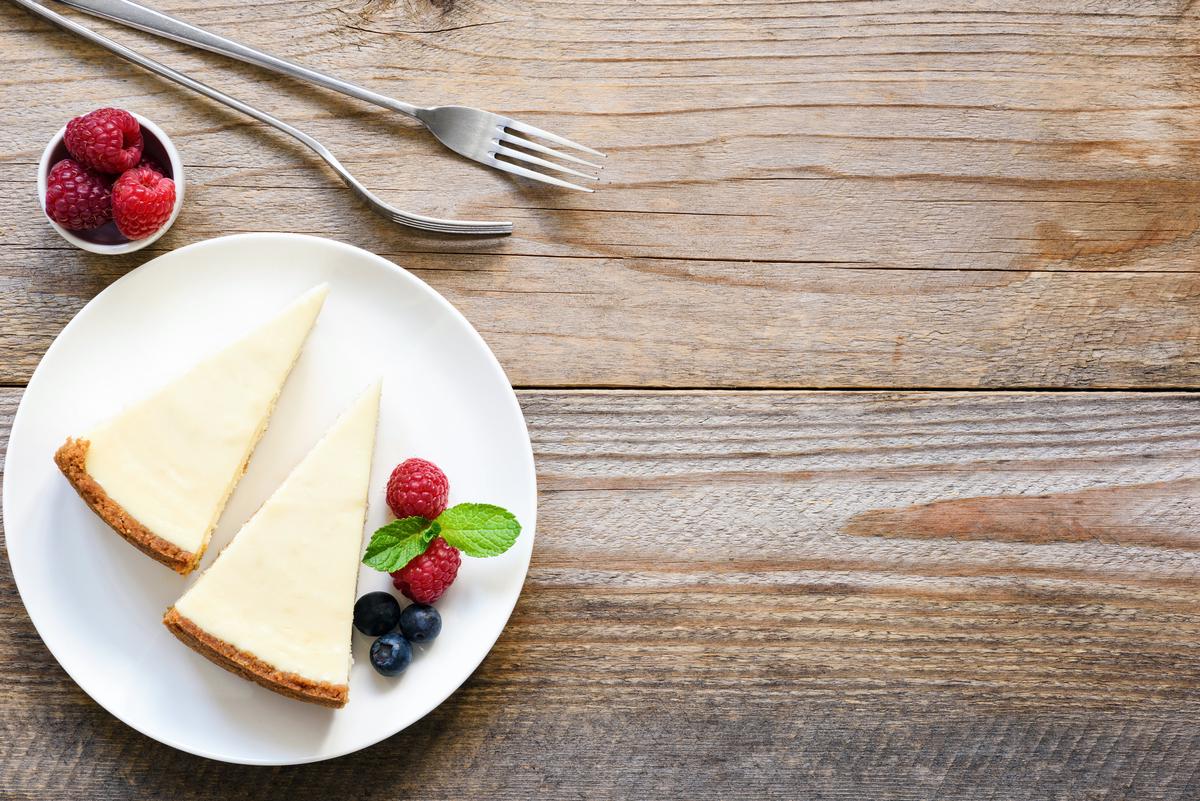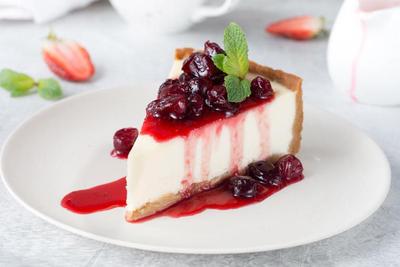🍰 Can Dogs Eat Cheesecake? - Fattening?
We explore the topic of the popular desert and whether it’s good or bad for your dog 🤔

Summary
Dogs can definitely enjoy the sweet treat as long as you keep their portions small. If your dog has an allergy to any ingredients used in cheesecake, then he/she shouldn’t be allowed to consume this dessert at all. However, there are some brands out there that claim that their products contain no egg so you might want to check those labels before giving your pup a bite.
What is it made of ⌛
Typical ingredients include: cream cheese, sugar, eggs, milk, vanilla extracts, and sometimes other flavourings such as chocolate chips, strawberries, etc. The texture of cheesecake varies from brand to brand but most of them tend to fall into two categories – Soft or Hard.
A soft version will melt easily on contact with warm hands while hard versions won’t crumble when handled roughly.
Is it good for dogs
Dogs do not benefit from eating sugary foods. In fact, the exact opposite is true – sugary treats can be harmful to dogs. As sweets are not a natural part of a canine diet, eating cheesecake or another sweet treat can upset a dog’s stomach and cause diarrhea 💩 or even vomiting. Your dog may also act hyperactive and unfocused and can also cause dental issues and for your dog.
As mentioned earlier, cheese cake isn’t just delicious for humans; they love it too. This tasty snack provides essential nutrients like calcium, phosphorus, protein, vitamin B12 zinc, iron, magnesium, potassium.

Bad for dogs? 🐕
Classic Cheesecake is made by mixing heavy cream cheese, sour cream, sugar, eggs, and desired flavoring. While there isn’t any scientific evidence proving that it’s harmful to dogs, some dog owners do not allow their pets to consume the desert due to concerns about allergies and digestive problems. If you want your pet to enjoy it, keep an eye on his/her diet so he/she does not get overindulged.
How do I feed my dog cheesecake?
It should always be fed sparingly because it contains high amounts of sugar. You may also need to adjust its serving size depending upon how much energy your pet needs each day. For example, if your dog weighs around 10 pounds, then one slice would serve him for about 20 minutes. On the other hand, if your pooch weighs more than 25 lbs then you could give him 2 slices per meal instead. It is best not to overfeed your canine friend since too many calories can lead to obesity problems later down the line.
How much is okay for dogs?
There is no specific amount that is considered healthy for dogs. While many people think that milk is good for dogs, there are actually several reasons why we shouldn’t feed our pets cow’s milk. Milk contains casein protein, an ingredient found in cows' milk that causes digestive issues such as diarrhea and vomiting in humans. In addition, it also contains lactose, another substance that may cause allergic reactions or gastrointestinal upset in animals who cannot digest lactose properly.
Egg yolk 🥚
Egg yolks contain high levels of cholesterol and fat. This means they could potentially lead to obesity if consumed regularly. Also, since most dogs don’t produce enough bile acids to break down these fats, consuming them will result in fatty liver disease.
Fatty foods
Fatty foods like butter 🧈, lard, shortening, and oils should never be fed to dogs because they increase the risk of pancreatitis. Pancreatic enzymes aren’t produced naturally in dogs, making them more susceptible to developing this condition when eating too much-saturated fat.
Sweeteners
Sugar is one of the worst things you can give to your dog. It’s highly toxic to canine cells and can even damage DNA inside cells. The best way to avoid feeding your dog sugary treats is to use natural alternatives instead. You can try using honey, molasses, maple syrup, agave nectar, coconut oil, and stevia extract.
Artificial flavors & colors ⚫
Artificial food dyes and artificial preservatives are dangerous substances that can harm both human and animal health. They’re often linked with hyperactivity, behavioural disorders, cancer, kidney failure, and reproductive system diseases.
The danger of raisin cheesecake
Raisins have been found to cause kidney failure in dogs. They are rich in potassium and magnesium, two minerals essential for maintaining proper blood pressure levels. When these minerals get depleted due to excessive consumption of raisins, there is a risk of developing hypertension. This condition results in damage to kidneys, heart, brain, eyes, liver, spleen, pancreas, etc., leading to severe complications.

Can puppies have it?
Yes! It depends upon how much you feed them. If you give them small portions at regular intervals, then there won’t be any problem. But if you overfeed them, then yes, they could have problems. So make sure that you don’t serve too many pieces of cheesecake to puppies. They need to grow slowly so that they do not get obese!
What about other types of cakes for dogs?
You might want to know about other types of cakes that are safe for dogs. There are different kinds of cakes available on the market today. Some of them include:
Banana 🍌
Banana cake is made up of bananas, eggs, flour, sugar, baking soda, salt, vanilla essence, and cinnamon. Bananas are full of vitamin B6, fiber, iron, calcium, phosphorus, zinc, copper, manganese, folate, riboflavin, thiamine, pantothenic acid, biotin, and vitamins A and E. These nutrients help keep your pet fit and active.
Strawberry 🍓
Strawberry cake consists of strawberries, cream cheese, egg whites, flour, sugar, lemon juice, and baking powder. Strawberries are loaded with antioxidants, flavonoids, folic acid, lycopene, beta-carotene, and Vitamin K. All these compounds protect against cardiovascular diseases, diabetes, arthritis, cataracts, depression, Alzheimer’s, and some cancers.
Orange 🍊
Orange cake includes orange zest, oranges, eggs, flour, brown sugar, baking powder, and salt.
Cream cheese
This ingredient is found in most types. It’s high-fat content makes it an excellent source of calories that dogs need. But if consumed regularly, this fat will cause weight gain in your pooch. Cheesecake may be delicious but it isn’t healthy! So make sure you feed your dog only homemade or low-calorie versions of this dessert.
The main problem is a lot of sugar and calories
The desert has more than twice the amount of sugar compared to other desserts like brownies or cookies. The average serving size of cheesecake is about 1/2 cup, which means each slice will have around 30 grams of sugar. That’s almost double what most people consider “healthy” amounts of sugar. It’s no wonder it’s one of America’s favourite treats.
My dog ate cheesecake – should I be worried?
In fact, most adult dogs are lactose intolerant. According to the American Kennel Club, a high-fat diet is a major cause of pancreatitis in dogs. That is why we do not recommend giving your dog cream cheese even if he or she has no problems digesting dairy products.
Healthy treat alternative?
There are plenty of healthier options when it comes to feeding your dog. Here are some ideas:
Oatmeal cookies
These tasty oatmeal cookies contain oats, butter, milk, raisins, chocolate chips, nuts, and dried fruit. They also provide essential minerals such as magnesium, potassium, phosphorous, sodium, and selenium. Oats are rich sources of dietary fibers, protein, carbohydrates, fats, and vitamins including niacin, thiamine, riboflavin.
Peanut butter sandwich
A peanut 🥜 butter sandwich contains peanuts, bread, jelly, honey, and margarine. Peanuts are packed with proteins, monounsaturated fatty acids, polyunsaturated fatty acids, cholesterol, and phytosterols. Phytoestrogens are plant estrogens, they reduce inflammation and prevent cancer growth.
Our final word
In conclusion, there are many different kinds of cakes for dogs available on the market today. However, all of them should be prepared from scratch using natural ingredients. If possible, try making your own version at home so you can control exactly how much sugar and calories go into your dog’s food.